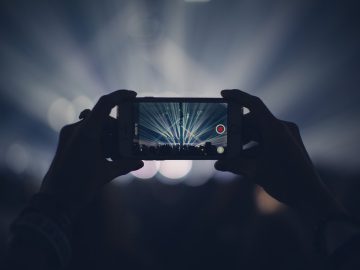Back in the late 90s when the attitude era was peaking in WWF, the Undertaker captured the attention of the masses with his “Deadman walking” theme. The legendary gimmick became a worldwide sensation, making “The Deadman” a household name. The prospect of a man rising from the grave and appearing before you is a thrilling yet scary concept. Accompanied by smoke and theatrics, the stunt pulled off by Mark Calaway took make-believe to the next level. Dead men can never walk or appear before you, as the now-retired wrestling entertainer Mark Calaway will testify.
Ghosts and fairies don’t exist. However, in the 21st-century era of AI, real men are seen walking, talking, and even singing long after they are dead. Live men are seen speaking and doing things that they never did.
On Nov 2023, a new Beatles song and video was released on YouTube 50 years after the band broke up. The song “Now and Then” was written by John Lennon shortly before he was murdered in 1980. Paul McCartney received the demo tape in 1994 from Lennon’s widow, but the song was never recorded. Beatles lost another member when George Harrison died in 2001.
Yet, they are all featured in the song recorded and released in 2023. A four-minute song melding archival shots of the Beatles along with surviving Beatles was recorded. An AI voice clone of singing John Lennon was created indistinguishably from a real voice. Beatles fans enjoyed the Beatles and their dead counterparts grooving to their song powered by AI.
In another instance of AI, several scenes of Paul Walker in the Hollywood movie Fast & Furious 7 were filmed after the death of the actor. Deepfakes have emerged as a useful tool for content creators. Whether it’s a director in a dilemma after the death of a star cast, an author creating a first draft of his book or a graphic designer struggling with ideas, AI is aiding in creation, even replacing creators. Seeing and listening no longer means believing.
Deepfakes: A product of generative AI
Generative AI is artificial intelligence that can create new digital content such as text, images, and audio by deep learning from data. Essentially, the AI feeds on loads of original digital content and learns the pattern using machine learning algorithms before replicating the same as “Deepfakes”.
In the case of the Beatles song, the Dead Beatles were created by algorithms after learning from their images, body language, audio, and videos. The Fast & Furious 7 sequence relied on advanced computer-generated imagery (CGI) combined with deepfakes to create an uncanny imitation of Paul Walker. Two types of neural networks are used to create deepfake videos: one generates fake content, while the other evaluates its realism. The two networks together are Generative Adversarial Networks(GANs) similar to an encoder-decoder architecture where the encoder consumes input while the decoder utilizes the compressed data from the encoder to reconstruct the desired output. In such a dual model, the quality and quantity of inputs determine the output. Apart from AI creation networks, numerous AI tools aid in specialized tasks like voice cloning and lip-syncing, resulting in videos that are hyper-realistic and indistinguishable from real ones.
The surge of deepfakes
With the proliferation of AI, the creation of deepfakes has become quick and cheaper, resulting in easy access to rogue elements on the internet. Besides ease of use through simple text prompts, various free AI tools and chatbots have led to a spike of deepfake memes, deepfake porn, and deepfake investment scams on the internet. Thus, social media today is rife with deepfake Elon Musk promoting crypto investment scams, PM Modi dancing to the tunes of Garba, and Donald Trump deepfakes courting controversy.
In South Korea, a deepfake scandal exploded when deepfake porn of school girls was created and shared on thousands of Telegram channels. In Hong Kong, a finance executive of an MNC transferred millions of dollars of company funds after attending a deepfake video conference, believing the hyperrealistic interaction of his company CFO and colleagues. In Kerala, a retired government servant thought he was smart for confirming a money request with a WhatsApp call.
The deepfake of his former colleague appeared on the video, and the elderly person generously contributed, believing what he heard and saw. Little did he realize that it was a deepfake. An Indonesian bank observed that the KYC of several bank accounts were deepfakes, and the real account holder isn’t known, leading to fear of money laundering, tax evasion, and other concerns of criminal activities.
Deepfake videos of Alia Bhatt and Rashmika Mandanna have appeared on social media, while deepfake videos of Home Minister Amit Shah emerged in the Lok Sabha elections. When the Prime Minister himself had to play deepfake detector and alert the public of deepfakes during the election campaign, we know that deepfakes are potent misinformation weapons. Trusting your eyes and ears is risky.
Deepfakes and the need for modern-day precautions
The WWE fans of the attitude era were raised in an era where users were warned to be wary before downloading or installing anything. We were cautious about setting a strong password. We scanned the devices with an anti-virus before double-clicking them open. As AI captures the digital world, these seem like precautions for a medieval age. We are entering an era where a deepfake will ask for your password and OTP or will just instruct you to transfer the money. If you aren’t constantly on guard for the possibility of a deepfake, a careless approach or a slip can compromise your entire organization’s data.
If you are forewarned, you may do well to double-check your boss during a video conference with a liveness detection query. How about asking, “Boss, what was written on the T-shirt I wore to the office yesterday?”. The only alternative to such paranoid behavior is the installation of deepfake detection tools.
By Ankush Tiwari, Founder & CEO, pi-labs






